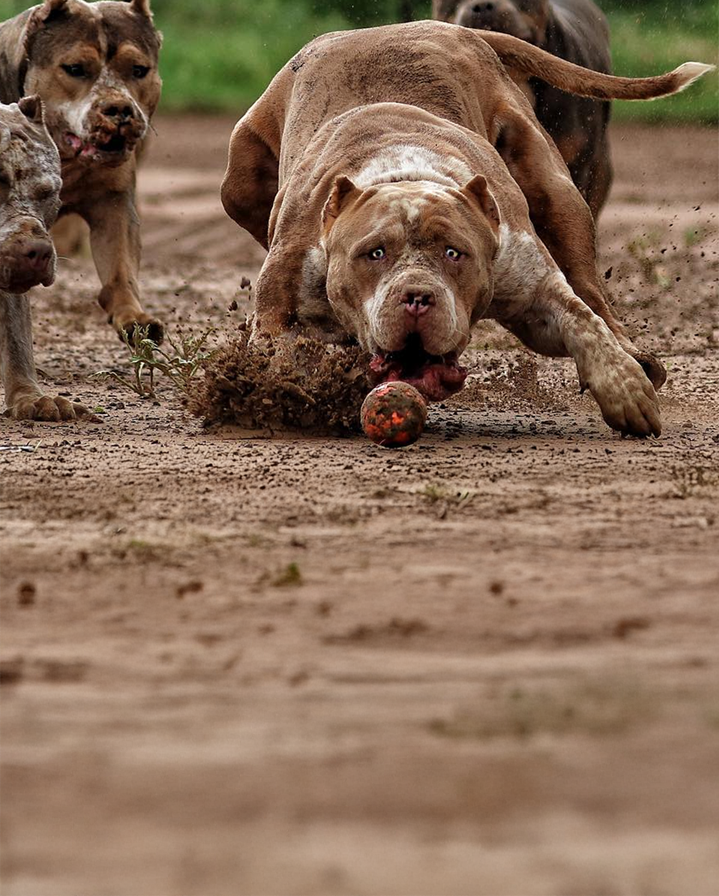How to Break Up a Dog Fight and How to Prevent Them
Pit bulls are a loyal and loving breed of dog with countless good qualities. And as a proud owner of this wonderful breed, it’s your responsibility to keep your dog—and other dogs in the area—safe and happy.
In order to do that, it’s important to take the proper steps to prevent dog fights.
In the right circumstances, all dogs will fight. But pit bulls fights can be more frequent and more severe if you don’t know how to prevent them.
A dog fight might sound scary, but the truth is that you can easily prevent them by making a few smart decisions. And if a fight does break out, you can break it up quickly as long as you know what to expect and how to react.
A Few Things You Need to Understand About Pit Bulls
- Pit bulls were bred for fighting. This doesn’t make them mean, bad, or evil; it’s just their heritage (similar to how many other dogs are bred for hunting).
- Other dog breeds will act out submission signals when they want to stop fighting, which usually signals the end of the fight. But pit bulls may ignore these signals, which means that a pit bull fight can lead to serious damage—or worse—if the fight is not broken up.
- Pit bulls are “people” dogs. They love spending time with people and enjoy attention and love from your family. They do not need another dog around to be happy.
What Causes Dogs to Fight?
- Dog fights can happen suddenly and without warning. Fights may be preceded by growling, barking, or posturing, but they may not be. Fights can even occur between dogs that have been close friends for years. And once two dogs have fought before, they are more likely to fight again in the future.
- Fights can be triggered by seemingly innocent causes, such as excitement and stimulation from seeing a squirrel or other small animal run by. Fights can also escalate from rough-housing, competing over a toy, or even out of jealousy (for example, if one dog is getting more attention from the family).
- Sexual hormones can cause dogs to behave much more aggressively than normal.
- Finally, tension between dogs can cause them to fight. And one sure source of tension is an unclear pecking order. If you have a fighting breed of dog, make sure to train it properly so that it clearly understands its place in the social hierarchy.
How to Prevent Dog Fights
The #1 best way to prevent dog fights in your home is to make the pit bull your only pet. As we mentioned above, pit bulls are “people dogs” who enjoy spending time with your family and do not need another dog to be happy.
If there’s no other dog around, there’s no one for your pit bull to fight with.
If you prefer to have more than one dog, here are 8 tips to minimize any chance of fighting:
- Get one male and one female. Same-sex dogs are more likely to fight. Two males (or two females) are much more likely to fight than a male and a female. This is true of every breed, not just pit bulls, because two dogs of the same sex are likely to see each other as rivals.
- Release pent-up energy by exercising your dogs. If dogs are not exercised frequently enough, they will build pent-up energy. This can lead to dog fights.
- Walk your dogs together. Walking your dogs together forms a stronger pack. Dogs that have formed a strong pack are less likely to fight.
- Spay or neuter your pit bulls as early as possible. Sexual hormones cause them to be much more aggressive than usual.
- Never leave your pit bull unsupervised with other animals. If you aren’t around to watch them, each pit bull should be crated or kept in a separate room.
- Watch your dogs when they are playing. Even innocent rough-housing can escalate into a fight if you aren’t paying attention. Remember, as the human you are the leader of the pack—it’s your job to set limits on the dogs’ behavior.
- Pick up dog toys, bones, and food when they’re not being used. Two dogs who stumble across a toy or a bone could start fighting over it.
- Always keep your pit bull on a leash when you take them for a walk, and keep them away from other unleashed dogs. This means that you should NEVER bring an adult pit bull to an off-leash dog park.
What If A Fight Does Break Out?
If your dog does start fighting, it’s important not to panic. Screaming and panicking will not stop a fight, it will only intensify it. By staying calming and using the proper tools, you can break up the fight quickly.
How to break up a dog fight, Method 1:
The two things you will need are a break stick (to pry the dog’s mouth open) and a collar or leash (to pull the dogs apart). It's important to keep collars on your dogs at all times. Breaking up a dog fight is more difficult when the dogs are not wearing collars.
A break stick is a stick you insert between the dog’s back teeth. Then, twist the stick to pry the dog’s mouth open.
Once the dog’s mouth is open and the hold is broken, grab their collars or leashes and pull UP. Avoid pulling them apart face to face at ground level, it will only make them fight more intensely. Separate the dogs as quickly as you can—by putting them in separate rooms, or tying one to a tree while you remove the other.
How to break up a dog fight, Method 2:
One of the FASTEST and SAFEST way to break up a dog fight is by grabbing both dogs by their collars and holding them in in the air as high as possible, so the dogs lose oxygen. Without oxygen, they will not be able to hold their grip.
Yes, one dog will usually lose oxygen before the other, but as long as both dog's front feet are off the ground and the collar is applying direct pressure to bottom of neck (as high up on neck as possible) they WILL lose oxygen and release their grip.
Do not hold the dogs in the air ANY longer than necessary — and that is the moment the dog releases its grip.
NEVER scold or hit your dog after a fight. Speak quietly to the dog to sooth it and reduce the arousal level. After the fight is over, it's important that you create peace, harmony, and balance.
The idea of a dog fight might sound scary, but as long as you follow this advice you shouldn’t have anything to worry about. Just be mindful of your dog’s heritage, and you’ll have a loving family member who will be a source of happiness for years to come.









138 comments
Alright I know this thread is like 3 years old but I need help. I have a pit mix who is 3 and an american bulldog who is 2. They won’t stop fighting and they shed a lot of blood. We don’t have enough money to get them neutered yet. Lifting them up on two legs sounds like a good idea but what if one is on top of the other then what should I do. The last time I tried to break up their fight my pit accidentally bit me. I have questions and need help before it gets way out of hand.
I heard air horns can help break up a dog fight as well.
My dog is half lab, half pittie. He’s very sweet and actually lives with 2 cats who he’s gentle with. He’s gentle with dogs smaller and even bigger than him but when he’s around dogs his size (like another pit bull or a german shepard) he goes nuts. I have no idea why this is but we had a pretty bad incident with him yesterday with another pitbull (pure bred) I’m saddened that you mentioned I should never bring my half pit to the off leash dog park, here in Miami, all dog parks are off leash and I don’t have big open spaces for him to play alone, what should I do? I did take him to doggie be good classes back in January, should I take him some more? I just want him to play well with other dogs his size!
So Sharon, what’s your solution? Just keep breeding them and breeding them while thousands are euthanized every single week because there aren’t enough homes to go around and the majority of people looking to adopt a dog don’t want a pit bull? What did the vet say that was incorrect? These dogs are capable of causing terrible damage to both people and other pets. 2017 isn’t over yet and 36 people have been killed by pit bulls. The number of family pets they maim and kill is in the thousands. I too question why anyone would choose this type of dog when there are so many other breeds and crosses to choose from that are safe.
You own ONE dog. She deals with dogs on a daily basis, and has a far larger sample size of dealing with pitbulls than you. And this is coming from the owner of a pitbull. They are great dogs, but are more aggressive by nature. This aggressiveness can be taken care of by a good owner, but not everyone is a good owner. Most people, by definition, are average or below average owners. And because bad owners cant handle them, they are euthanized more. I don’t want to see a puppy brought into this world just to go that way.